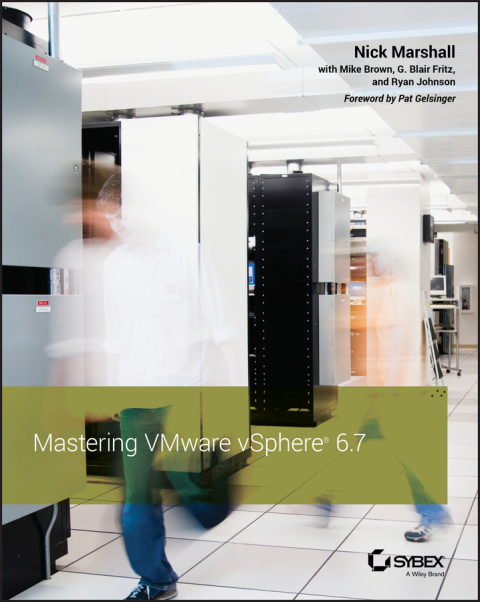Description
Efnisyfirlit
- Cover
- Acknowledgments
- About the Author
- About the Contributors
- Foreword
- Introduction
- What Is Covered in This Book
- The Mastering Series
- The Hardware Behind the Book
- Who Should Buy This Book
- How to Contact the Authors
- Chapter 1: Introducing VMware vSphere 6.7
- Exploring VMware vSphere 6.7
- Why Choose vSphere?
- The Bottom Line
- Chapter 2: Planning and Installing VMware ESXi
- VMware ESXi Architecture
- Planning a VMware vSphere Deployment
- Deploying VMware ESXi
- Performing Post-installation Configuration
- The Bottom Line
- Chapter 3: Installing and Configuring vCenter Server
- Introducing vCenter Server
- Choosing the Version of vCenter Server
- Planning and Designing a vCenter Server Deployment
- Installing vCenter Server and Its Components
- Installing vCenter Server in an Enhanced Linked Mode Group
- Exploring vCenter Server
- Creating and Managing a vCenter Server Inventory
- Exploring vCenter Server’s Management Features
- Managing vCenter Server Settings
- vSphere Web Client Administration
- VMware Appliance Management Administration
- The Bottom Line
- Chapter 4: vSphere Update Manager and the vCenter Support Tools
- vSphere Update Manager
- vSphere Update Manager and the vCenter Server Appliance
- Configuring vSphere Update Manager
- Creating Baselines
- Routine Updates
- Upgrading Hosts with vSphere Update Manager
- Performing an Orchestrated Upgrade
- Investigating Alternative Update Options
- vSphere Auto Deploy
- Deploying Hosts with Auto Deploy
- vCenter Support Tools
- The Bottom Line
- Chapter 5: Creating and Configuring a vSphere Network
- Putting Together a vSphere Network
- Working with vSphere Standard Switches
- Working with vSphere Distributed Switches
- Configuring Virtual Switch Security
- The Bottom Line
- Chapter 6: Creating and Configuring Storage Devices
- Reviewing the Importance of Storage Design
- Examining Shared Storage Fundamentals
- Implementing vSphere Storage Fundamentals
- Leveraging SAN and NAS Best Practices
- The Bottom Line
- Chapter 7: Ensuring High Availability and Business Continuity
- Understanding the Layers of High Availability
- Clustering VMs
- Implementing vSphere High Availability
- Introducing vSphere SMP Fault Tolerance
- Planning for Business Continuity
- The Bottom Line
- Chapter 8: Securing VMware vSphere
- Overview of vSphere Security
- Securing ESXi Hosts
- Securing vCenter Server
- Securing Virtual Machines
- The Bottom Line
- Chapter 9: Creating and Managing Virtual Machines
- Understanding Virtual Machines
- Creating a Virtual Machine
- Installing a Guest Operating System
- Installing VMware Tools
- Managing Virtual Machines
- Modifying Virtual Machines
- The Bottom Line
- Chapter 10: Using Templates and vApps
- Cloning VMs
- Creating Templates and Deploying Virtual Machines
- Using OVF Templates
- Using Content Libraries
- Working with vApps
- Importing Machines from Other Environments
- The Bottom Line
- Chapter 11: Managing Resource Allocation
- Reviewing Virtual Machine Resource Allocation
- Working with Virtual Machine Memory
- Managing Virtual Machine CPU Utilization
- Using Resource Pools
- Regulating Network I/O Utilization
- Controlling Storage I/O Utilization
- The Bottom Line
- Chapter 12: Balancing Resource Utilization
- Comparing Utilization with Allocation
- Exploring vMotion
- Ensuring vMotion Compatibility
- Using Storage vMotion
- Combining vMotion with Storage vMotion
- Cross-vCenter vMotion
- Exploring vSphere Distributed Resource Scheduler
- Working with Storage DRS
- The Bottom Line
- Chapter 13: Monitoring VMware vSphere Performance
- Overview of Performance Monitoring
- Using Alarms
- Working with Performance Charts
- Working with esxtop
- Monitoring CPU Usage
- Monitoring Memory Usage
- Monitoring Network Usage
- Monitoring Disk Usage
- The Bottom Line
- Chapter 14: Automating VMware vSphere
- Why Use Automation?
- vSphere Automation Options
- Automating with PowerCLI
- Additional Resources
- The Bottom Line
- Appendix A: The Bottom Line
- Chapter 1: Introducing VMware vSphere 6.7
- Chapter 2: Planning and Installing VMware ESXi
- Chapter 3: Installing and Configuring vCenter Server
- Chapter 4: vSphere Update Manager and the vCenter Support Tools
- Chapter 5: Creating and Configuring a vSphere Network
- Chapter 6: Creating and Configuring Storage Devices
- Chapter 7: Ensuring High Availability and Business Continuity
- Chapter 8: Securing VMware vSphere
- Chapter 9: Creating and Managing Virtual Machines
- Chapter 10: Using Templates and vApps
- Chapter 11: Managing Resource Allocation
- Chapter 12: Balancing Resource Utilization
- Chapter 13: Monitoring VMware vSphere Performance
- Chapter 14: Automating VMware vSphere
- Index
- End User License Agreement





